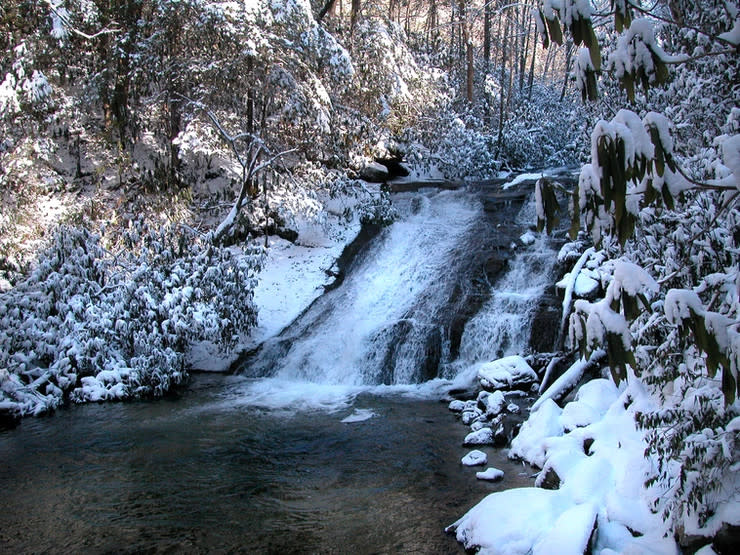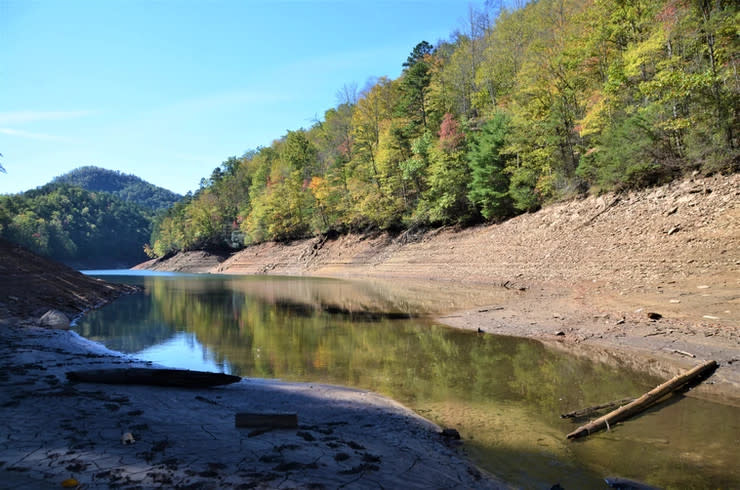Winter in the mountains is most associated with staying indoors, snuggled up by a roaring fire as the cold and snow whip through the treetops. Did you also know, though, that winter is one of the best times to get out and explore the many wonderful hiking trails that crisscross through the Great Smoky Mountains? When the temperatures drop, crowd levels follow, meaning you can enjoy an adventure crunching through snow and wintery underbrush with virtually no others on our trails. We’ve rounded up five of our favorite routes to explore this winter.
1. Listen to the Rush of Water at Deep Creek

Indian Creek Falls
The three waterfalls of Deep Creek are a must-see stop on your Bryson City vacation regardless of the season. However, in the winter months, the hustle and bustle of activity in this section of the Great Smoky Mountains National Park calms, allowing you to walk through a virtually undisturbed natural paradise with little but the sounds of soothing rushing water coming from Tom Branch, Juneywhank and Indian Creek Falls serenading your journey. There are several routes to take when exploring Deep Creek, the longest of which stretches just over 4 miles and loops past Tom Branch and Indian Creek Falls. Another route is a 2.4-mile loop that swings you to Juneywhank Falls, a beautiful cascade that can be viewed from a bridge stretching across. Seating is available at several points throughout Deep Creek, giving you a place to sit and enjoy the ambiance. Deep Creek is easily accessible from Bryson City, located just a few short miles away from downtown.
2. Explore the Blue Ridge Parkway - on Foot!

Most known as one of the most beautiful drives in the US, the Blue Ridge Parkway winds for 469 miles through North Carolina and up to Virginia, bordered by unparalleled mountain beauty. While bustling with activity in the warmer months, many stretches of this famed roadway are closed in the winter. This offers you a unique opportunity to explore the parkway and its many overlooks from a new perspective: on foot! Drive to one of the parkway’s access points near Bryson City, park and walk along the historic Blue Ridge Parkway, soaking in up-close views of sweeping overlooks, towering waterfalls and more. The Parkway access point closest to Bryson City lies at Milepost 469.1, right at the Cherokee entrance to the Great Smoky Mountains National Forest. Another nearby access point lies close to Waynesville at Balsam Gap (Milepost 443.1).
3. Venture Along the Historic Appalachian Trail

The Appalachian Trail (AT) is one of our country’s most historic, with many placing it high on their bucket list. Hiking the full length of this 2,190-mile trail, which starts in Georgia and ends in Maine, takes time, stamina, patience and fierce determination, so much so that many decide to break the hike into sections, covering only select stretches of the trail at a given time. Bryson City is home to many access points along the Appalachian Trail, making it part of our regular lineup of breathtaking, but often strenuous hikes. The Appalachian Trail is a wonderful, picturesque trek to explore in the winter months when many points of the trail’s higher elevation stretches are blanketed in snow. The trail also allows you to venture to a number of areas that are not accessible in the winter months due to ice and snow along roadways, like Clingmans Dome. The visitors center and observation are both closed during the winter months, however, you can still enjoy the wonderful views from atop the highest point in the Smokies via the AT. During the winter months, the Appalachian Trail is best accessed from a point just south of the Nantahala Gorge.
4. Step Into History at Mingus Creek

Mingus Creek Trail, located just up the road from Bryson City near the Oconaluftee Visitors Center, is at its longest, a moderate, six-mile roundtrip hike with an elevation change of just over 1,000 feet. The trail also has easier, shorter route options available for those looking for a casual stroll. All routes, however, will take you past one of the coolest historic sights in our slice of the Great Smoky Mountains. Built in 1886, Mingus Mill stands as a remnant of our past. This water-powered grist mill once serviced a broad number of communities, grinding corn into other usable products like cornmeal. In the summer months, skilled caretakers run the mill to showcase the more traditional ways we used to prepare foods and other goods, allowing for tours of the mill’s main building, too. During the winter, the interior of the mill is closed, but the rushing water of its flume and exterior of the mill can still be viewed. Other sights along the trail include a historic cemetery and the remnants of an old Civilian Conservations Corps camp.
5. See the Shallow Waters of Fontana Lake

Goldmine Loop Trail at Fontana Lake
In the warm summer months, Fontana Lake is alive and swimming with boaters, fishers and more, with aquatic adventure found from shoreline to shoreline. In the winter, this sparkling gem of our destination is partially drained, giving you a once-a-year chance to see Fontana’s impressive depths. While its namesake dam is closed, there are many hiking trails that twist and turn through its wooded borders. Some of these wind by Hazel Creek and the Lost Town of Proctor, one of many hidden gem attractions in Bryson City. Once a thriving lumber town, the area was flooded as part of the creation of Fontana Lake. The remnants of this small community can now only be seen when lake levels are low. Another trail that loops around Fontana is the Tsali Trail, popular among mountain bikers and in warmer months, a lovely spot for guided horseback tours. It’s a wonderful loop to explore and get picture-perfect views of Fontana Lake.
When exploring our wintery and often snowy mountainsides, please bring all necessary safety gear to make sure you stay safe and warm on all hiking trails. Packing proper footwear that has exceptional grip and wearing versatile layers are essential to your winter hiking journey, as are bringing snacks, water and sunglasses - sunlight on freshly fallen snow is incredibly bright! Always make sure to check the weather before venturing out and be prepared with a backup plan, too. Some of our hikes at higher elevations will not be as pleasant if the temperatures drop too low. In this scenario, a lower elevation hike is recommended. You will also want to time your hikes properly as winter’s shorter days leave you with less daylight. Above all, though, have fun!
Exploring the Great Smoky Mountains during the winter months is a special, magical experience that can’t be missed. Grab your gear and get ready for adventure! For information on the different hikes and trails in Bryson City, visit www.explorebrysoncity.com
